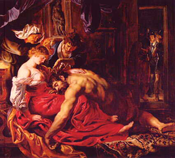
09 Apr 2007
SAINT-SAËNS: Samson et Dalila
Samson et Dalila, grand opera in three acts and four tableaux.
Mozart and Salieri, an opera in one act consisting of two scenes.
Nicolai Rimsky-Korsakov (1844-1908), composer. Libretto derived from Alexander Puskhin's play of the same name.
First performance: 7 December 1898 in Moscow.
Ariadne auf Naxos, Oper with a prologue and one act. Music composed by Richard Strauss. Libretto by Hugo von Hofmannsthal.
La Vestale, a tragédie lyrique in three acts.
Boris Godunov, an opera in four acts with prologue
Modest Mussorgsky, composer. Libretto by the composer, based on Alexander Pushkin's drama Boris Godunov and Nikolai Karamazin's History of the Russian Empire
First performance: 8 February 1874 at the Mariinsky Theatre, St. Petersburg
Il Trovatore, dramma in four parts.
Only a few months following the premiere of Der Rosenkavalier, Hugo von Hofmannsthal proposed a new opera to Richard Strauss based on Molière’s comedy-ballet, Le Bourgeois gentilhomme (in German, Der Bürger als Edelmann).
Die Entführung aus dem Serail, Singspiel in 3 Acts.
Music composed by Wolfgang Amadeus Mozart (1756–1791). Libretto by Johann Gottlieb Stephanie the Younger, based on an earlier libretto by
Christoph Friedrich Bretzner.
Die Entführung aus dem Serail, Singspiel in 3 Acts.
Music composed by Wolfgang Amadeus Mozart (1756–1791). Libretto by Johann Gottlieb Stephanie the Younger, based on an earlier libretto by
Christoph Friedrich Bretzner.
Arabella: Lyrische Komödie in three acts
Die Entführung aus dem Serail, Singspiel in 3 Acts.
Music composed by Wolfgang Amadeus Mozart (1756–1791). Libretto by Johann Gottlieb Stephanie the Younger, based on an earlier libretto by
Christoph Friedrich Bretzner.
La Gioconda, dramma lirico in four acts.
Music composed by Amilcare Ponchielli (1834–1886). Libretto by Arrigo Boito (under the pseudonym Tobia Gorrio), based upon Victor Hugo's Angelo, Tyrant of Padua (1835).
Don Carlo, an opera in four acts. Music composed by Giuseppe Verdi (1813–1901). Libretto by Joseph Méry and Camille Du Locle after Friedrich von Schiller’s dramatic poem Don Carlos, Infant von Spanien. Revised version in four acts (French text revised by Du Locle, Italian translation by Achille de Lauzières and Angelo Zanardini).
Un ballo in maschera, a melodramma in three acts.
Music composed by Giuseppe Verdi. Libretto by Antonio Somma, based upon the work of Eugène Scribe Gustave III ou Le bal masqué (1833)
Medea: Melodramma tragico in three acts.
Die Tote Stadt, an opera in three acts.
Music composed by Erich Wolfgang Korngold (1897-1957). Libretto by Paul Schott (Julius and E. W. Korngold) after the novel Bruges la morte by Georges Rodenbach.
Some Details concerning the Revolution inaugurated by Rossini
Manon Lescaut, dramma lirico in quattro atti
Elektra: Tragedy in one act.
Lyric Opera of Chicago has announced both schedules and cast-lists for is Spring 2020 performances of Richard Wagner’s Ring Cycle. Given the series of individual productions already staged by the company since Fall 2016, that pave the way for the complete cycle, Lyric Opera of Chicago’s complete production should affirm the artistic might of the great composer.
“Diacono himself does not know what musical talent he possesses” – Mascagni

Samson et Dalila, grand opera in three acts and four tableaux.
Streaming Audio
Music composed by Camille Saint-Saëns (1835-1921). Libretto by Ferdinand Lemaire.
First Performance: 2 December 1877, Grossherzogliches Theater, Weimar.
| Principal Characters: | |
| Samson | Tenor |
| Abimélech (Abimelech), satrap of Gaza | Bass |
| The High Priest of Dagon | Baritone |
| First Philistine | Tenor |
| Second Philistine | Bass |
| A Philistine Messenger | Tenor |
| Dalila (Delilah) | Mezzo-Soprano |
| An Old Hebrew | Bass |
Setting: Ancient Gaza.
Synopsis:
Act I:
Palestine, 1150 B.C. In a square in Gaza, a group of Hebrews beg Jehovah for relief from their bondage to the Philistines; Samson, their leader, rebukes them for their lack of faith. When the Philistine commander, Abimélech, denounces the Hebrews and their God, Samson kills him and leads the Hebrews away. The High Priest of Dagon comes from the Philistine temple and curses Samson's prodigious strength, leaving with the slain man's bier. An Old Hebrew praises the returning Samson. The outer walls of the temple disappear to reveal Samson's former lover, the Philistine woman Dalila, who invites him to come that night to her nearby dwelling. She and her maidens dance seductively for Samson, who becomes deaf to the Old Hebrew's dour prophecies.
Act II:
In the vale of Sorek, Dalila calls on her gods to help her ensnare and disarm Samson, promising the High Priest to find a way to render the hero powerless. Samson appears, passionate in spite of himself; when Dalila has him in her power, she feigns disbelief in his constancy and demands that he show his love by confiding in her the secret of his strength, weeping when he refuses. Samson hears rolling thunder as a warning from God but cannot resist following Dalila inside. Not long afterward, having finally learned that the secret of Samson's strength is his long hair, she calls to hidden Philistine soldiers, who rush in to capture and blind Samson.
Act III:
In a dungeon at Gaza, the sightless Samson pushes a grist mill in a circle, praying for his people, who will suffer for his sin. He hears their voices castigating him.
During a bacchanal in the Temple of Dagon, Dalila and the High Priest taunt Samson. When they force him to kneel to Dagon, he asks a boy to lead him to the two main pillars of the temple. Samson prays to Jehovah to restore his strength, and with a mighty effort he pulls down the pillars and the temple, crushing himself and his foes.